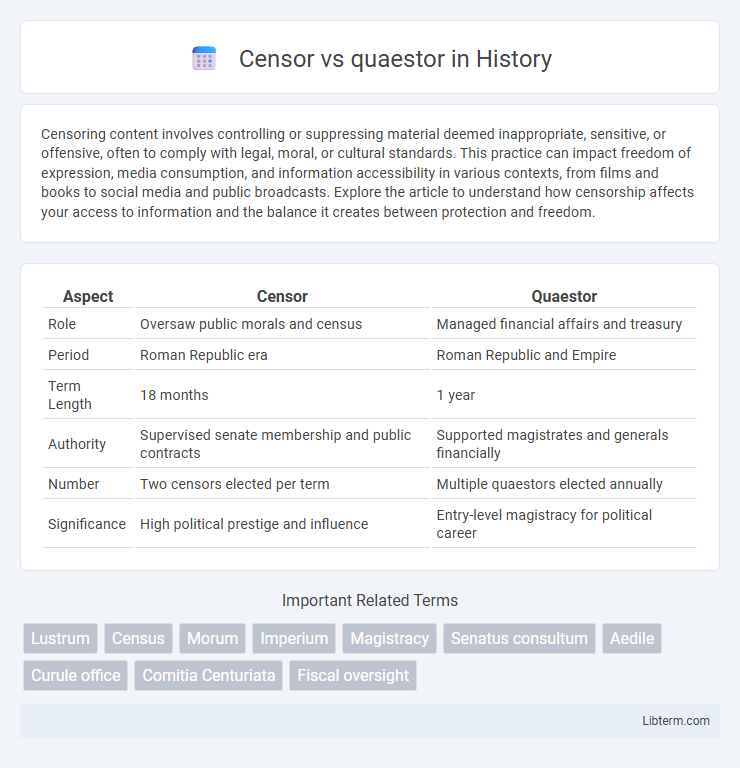Censoring content involves controlling or suppressing material deemed inappropriate, sensitive, or offensive, often to comply with legal, moral, or cultural standards. This practice can impact freedom of expression, media consumption, and information accessibility in various contexts, from films and books to social media and public broadcasts. Explore the article to understand how censorship affects your access to information and the balance it creates between protection and freedom.
Table of Comparison
| Aspect | Censor | Quaestor |
|---|---|---|
| Role | Oversaw public morals and census | Managed financial affairs and treasury |
| Period | Roman Republic era | Roman Republic and Empire |
| Term Length | 18 months | 1 year |
| Authority | Supervised senate membership and public contracts | Supported magistrates and generals financially |
| Number | Two censors elected per term | Multiple quaestors elected annually |
| Significance | High political prestige and influence | Entry-level magistracy for political career |
Introduction to Censor and Quaestor
The Censor in ancient Rome held significant responsibilities related to maintaining the census, overseeing public morals, and supervising certain aspects of government finances, often wielding considerable influence over the Senate's composition. The Quaestor, in contrast, primarily managed financial administration, including the treasury and military funds, serving as an essential magistrate responsible for fiscal duties and public accounts. Both offices were crucial to the Roman Republic's governance structure, with the Censor focusing on social and moral oversight, while the Quaestor ensured efficient financial management.
Historical Origins of Censor
The office of Censor in ancient Rome originated around 443 BCE, established to oversee the census, public morals, and the maintenance of the Senate's membership, reflecting the Republic's emphasis on social order and political accountability. Unlike the quaestor, whose primary role was financial administration and treasury management, the Censor held significant influence in regulating moral conduct and conducting the census every five years, which determined citizens' social status and taxation. The Censor's unique authority to revise the Senate roll and enfore ethical standards made this role a fundamental institution in maintaining the Republic's structure and societal discipline.
Historical Origins of Quaestor
The historical origins of the quaestor trace back to the Roman Republic, where quaestors served as the earliest financial magistrates responsible for treasury management and fiscal administration. Unlike censors, who emerged later with duties tied to the census and public morals, quaestors primarily managed state funds and military payments, marking the foundation of Rome's bureaucratic system. Their role evolved from purely fiscal tasks to include supervisory functions over public spending, reflecting Rome's complex political and administrative structure.
Key Roles and Responsibilities of Censor
The Censor in ancient Rome was responsible for conducting the census, overseeing public morals, and supervising the Senate's membership, ensuring integrity and social order. Unlike the Quaestor, who managed financial affairs and treasury duties, the Censor held authority to review and regulate citizens' conduct, revise the list of senators, and allocate public contracts. These key roles positioned the Censor as a guardian of state ethics and population records, crucial for political and social stability.
Key Duties and Functions of Quaestor
Quaestors primarily managed the financial affairs of the Roman state, overseeing the treasury, supervising public revenues and expenditures, and managing fiscal records. They were responsible for disbursing payments to the military and other public officials, ensuring accurate accounting and financial administration in provincial and urban settings. In contrast, censors held broader duties focused on conducting the census, regulating public morals, and supervising public contracts and infrastructure projects.
Selection Process: Censor vs Quaestor
The selection process for Censors involved election by the Centuriate Assembly, usually after significant political or military service, emphasizing seniority and moral integrity. Quaestors were appointed through election or nomination, often at younger ages, serving as financial administrators and entry-level magistrates. The Censor's election was more exclusive and infrequent, reflecting higher authority, while Quaestor appointments were more routine and served as a stepping stone in the cursus honorum.
Term Lengths and Authority Differences
Censors in ancient Rome served an 18-month term, wielding broad authority over the census, public morality, and state contracts, while quaestors held one-year terms primarily managing financial affairs and treasury oversight. Censors possessed extensive powers to revise the senatorial list and oversee public morals, contrasting with quaestors' more limited administrative and fiscal responsibilities. The term length disparity reflects the more enduring and influential role of the censor compared to the quaestor's entry-level position in the cursus honorum.
Impact on Roman Governance
The Censor wielded significant influence over Roman governance by supervising the census, public morality, and state finances, thereby shaping citizen status and resource allocation. In contrast, the Quaestor primarily managed financial administration and treasury operations, providing essential support for military and governmental expenditures. The Censor's authority to revise senatorial rolls and enforce moral standards held deeper long-term implications for the social and political structure than the Quaestor's fiscal duties.
Notable Figures: Famous Censors and Quaestors
Famous Roman censors such as Appius Claudius Caecus, known for his extensive public works and census reforms, significantly shaped Roman society and infrastructure. Notable quaestors include Publius Cornelius Scipio Africanus, who managed military resources during the Second Punic War, demonstrating essential financial and administrative skills. These figures exemplify the distinct yet complementary roles of censors as overseers of morality and public contracts, and quaestors as fiscal officers managing state finances.
Conclusion: Comparing Censor and Quaestor
The Censor held a higher-ranking office with duties centered on maintaining the moral integrity and conducting the census of Roman citizens, while the Quaestor primarily managed financial affairs and treasury functions. The Censor's role wielded broader social and political influence, often overseeing public morality and infrastructure, compared to the more administrative and fiscal responsibilities of the Quaestor. Therefore, the Censor's position was generally considered more prestigious and impactful within the Roman Republic hierarchy.
Censor Infographic

 libterm.com
libterm.com